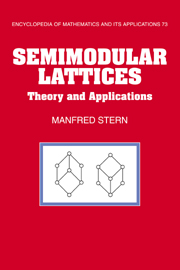Book contents
- Frontmatter
- Contents
- Preface
- 1 From Boolean Algebras to Semimodular Lattices
- 2 M-Symmetric Lattices
- 3 Conditions Related to Semimodularity, 0-Conditions, and Disjointness Properties
- 4 Supersolvable and Admissible Lattices; Consistent and Strong Lattices
- 5 The Covering Graph
- 6 Semimodular Lattices of Finite Length
- 7 Local Distributive
- 8 Local Modularity
- 9 Congruence Semimodularity
- Master Reference List
- Table of Notation
- Index
1 - From Boolean Algebras to Semimodular Lattices
Published online by Cambridge University Press: 05 May 2010
- Frontmatter
- Contents
- Preface
- 1 From Boolean Algebras to Semimodular Lattices
- 2 M-Symmetric Lattices
- 3 Conditions Related to Semimodularity, 0-Conditions, and Disjointness Properties
- 4 Supersolvable and Admissible Lattices; Consistent and Strong Lattices
- 5 The Covering Graph
- 6 Semimodular Lattices of Finite Length
- 7 Local Distributive
- 8 Local Modularity
- 9 Congruence Semimodularity
- Master Reference List
- Table of Notation
- Index
Summary
Sources of Semimodularity
Summary. We briefly indicate some milestones in the general development of lattice theory. In particular, we outline the way leading from Boolean algebras to semimodular lattices. Most of the concepts mentioned in this section will be explained in more detail later. We also give a number of general references and monographs on lattice theory and its history.
Boolean Algebras and Distributive Lattices
Lattice theory evolved in the nineteenth century through the works of George Boole, Charles Saunders Peirce, and Ernst Schröder, and later in the works of Richard Dedekind, Garrett Birkho21, Oystein Ore, John von Neumann, and others during the first half of the twentieth century. Boole [1847] laid the foundation for the algebras named after him. Since then the more general distributive lattices have been investigated whose natural models are systems of sets. There are many monographs on Boolean algebras and their applications, such as Halmos [1963] and Sikorski [1964]. For the theory of distributive lattices we refer to the books by Grätzer [1971] and Balbes & Dwinger [1974].
Modular Lattices
Dedekind [1900] observed that the additive subgroups of a ring and the normal subgroups of a group form lattices in a natural way (which he called Dualgruppen) and that these lattices have a special property, which was later referred to as the modular law. Modularity is a consequence of distributivity, and Dedekind's observation gave rise to examples of nondistributive modular lattices.
Lattice theory became established in the 1930s due to the contributions of Garrett Birkhoff, Ore, Menger, von Neumann, Wilcox, and others.
Information
- Type
- Chapter
- Information
- Semimodular LatticesTheory and Applications, pp. 1 - 72Publisher: Cambridge University PressPrint publication year: 1999
Accessibility standard: Unknown
Why this information is here
This section outlines the accessibility features of this content - including support for screen readers, full keyboard navigation and high-contrast display options. This may not be relevant for you.Accessibility Information
- 1
- Cited by
